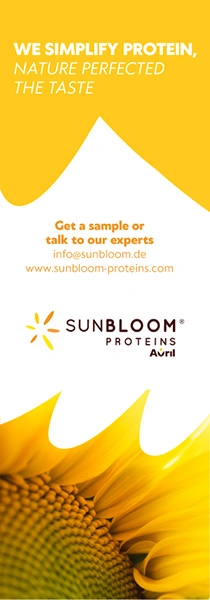
- Industry news
Industry news
Trending now
- Category news
- Reports
Trending now
- Key trends
Trending now
- Multimedia
Multimedia
Trending now
- Journal
- Events
Trending now
- Suppliers
Suppliers
Trending now
- Home
- Industry news
Industry news
Trending now
- Category news
- Reports
Trending now
- Key trends
Trending now
- Multimedia
Multimedia
Trending now
- Events
Trending now
- Suppliers
Suppliers
Trending now
Clean label trends: European consumer insights
How clean label trends are shaping Europe’s nutrition product innovation

Across Europe, consumer demand for transparency, health, and naturality is driving the popularity of clean label products. With a growing emphasis on knowing what goes into their food, consumers are looking for items made from recognizable, simple, and minimally processed ingredients. Innova Market Insights’ Innova360 research highlights the demand for sustainability and authenticity, driving clean label trends and innovation across the food industry.
Consumer clean label preferences
Consumers in Europe are increasingly focusing on clean label products, with a growing preference for natural and unprocessed F&B products with established health benefits. Over the past year, they have increasingly associated healthy food and beverages with being fresh and natural.
Moreover, 1 in 2 consumers reveal they purchased more fresh and unprocessed products during the same period, and 66% cite natural foods and ingredients as essential for a healthy, balanced diet. This shift toward natural foods reflects a growing awareness of healthier alternatives and a rising trend toward reducing the consumption of processed foods.
At the same time, 47% of consumers reveal they actively limit sugar, followed closely by fat, salt, and artificial additives. This finding may reflect an increasing consumer commitment to prioritizing healthy eating habits.
When purchasing a healthy snack, consumers also say they prioritize claims such as “natural,” “nutrition-boosting,” and “clean labels,” with the absence of additives or preservatives ranking as the most important attribute.
Clean label product launch trends
The European food industry is expanding, with 35% of recent product launches featuring clean label claims. The top 5 claims are:
- “Ethical-environment”
- “Organic”
- “No additives/preservatives”
- “Natural”
- “GMO-free”
Among these, ethical environmental claims have seen the fastest growth over the past five years, followed by natural claims and those highlighting no additives or preservatives. As a result, Europe has become a leading region for environmental and organic claims, achieving 13% market penetration in the past year.
Clean labels are also prominent in the Baby and Toddler category, followed by soup, hot drinks, and cereals. The fastest growing categories include Desserts and Ice Cream, Meat Substitutes, Hot Drinks, and Confectionery.
Nutrition transparency trends
Clean label factors strongly influence consumers’ product purchasing decisions. Natural (47%) and locally sourced/produced (45%) are the leading influential claims cited by consumers in Europe, highlighting consumers’ increasing trust in local products. Consumers increasingly prefer natural, unprocessed foods for essential nutrients and a healthy, balanced diet.
Consumers increasingly prefer natural, unprocessed foods for essential nutrients and a healthy, balanced diet.
However, 15% of consumers say that they often choose alternative products because of concerns about ingredient transparency, while 37% of people say they believe a product’s ingredient list is trustworthy only if it contains real, recognizable ingredients.
Clean label ingredients trends
Consumers are willing to embrace unfamiliar or novel ingredients if they are more natural, leading to product launches offering clean and natural benefits. One example is Fermentful’s fermented drink, which the company says is sourced from green buckwheat and 100% plant-based.
In response to the increasing consumer demand for recognizable ingredients, product innovators are incorporating more natural sweeteners in their offerings.
Simultaneously, many brands say they are prioritizing the use of single, unprocessed ingredients that offer inherent nutritional value and are in line with the preferences of health-conscious consumers.
Clean label sustainability trends
Consumers in Europe also reveal that they are becoming more aware of the environmental impact of food production and are, therefore, seeking products with a lower environmental footprint. Innova360 data suggests that 61% of consumers agree that natural and botanical flavor ingredients are more sustainable, and 41% indicate a willingness to pay a premium for products containing these ingredients.
In Europe, more than half of consumers report they trust environmental claims in products to some extent and prefer to see such claims on packaging. Ethical-environmental claims show the largest growth in the clean label space.
Ethical-environmental claims show the largest growth in the clean label space.
Additionally, the research reveals that clean label trends extend beyond sustainable production and focus on food origin and locally sourced products. For instance, Den Sorte Havre’s oatmeal claims to use 100% Norwegian-grown organic black oats, which showcases the company’s commitment to local sourcing and organic production.
Next-gen clean label products
The newest wave of clean label product launches focuses on short and informative ingredient lists with fewer additives. Innovators are highlighting that simplicity and a minimal number of ingredients align with consumers’ growing transparency preferences.
Consumers say they find products that are closer to their natural state more appealing. This preference makes raw ingredients a key trend in clean label product launches.
Consumers also report that they prefer products that are artisanal or handmade — a trend that is driven by the desire for real, natural ingredients, and minimally processed foods.
What’s next in clean label trends?
As consumers continue to associate clean-labels with transparency, simplicity, and sustainability, fresh, natural, and minimally processed ingredients are likely to remain healthy eating preferences. Environmental and ethical considerations, alongside clear labeling and technological integration, are increasingly important in shaping purchasing decisions. Short, simple ingredient lists build consumer trust and meet the demands for transparency and minimal processing.
Short, simple ingredient lists build consumer trust and meet the demands for transparency and minimal processing.
Additionally, clean-labels are evolving to meet the demand for plant-based products and natural ingredients. Brands can explore innovative uses of botanicals and plant-based flavors to enhance taste and offer added health benefits.
These ingredients can appeal to consumers seeking premium and sustainable options. Technological integration can further support transparency by offering detailed provenance and environmental information. Brands can leverage scanning apps or connectivity technologies to improve communication around product healthiness and ethical sourcing.
The clean label trend can extend its reach by addressing the “free-from” category and spotlighting nutrient-enriched products. Brands are also likely to introduce more high-protein and plant-based offerings that align with clean label principles, while maintaining a strong focus on health and sustainability to appeal to the wider consumer base.
This article is based on the Innova Market Insights report, “Now & Next in Clean-Label in Europe.”










